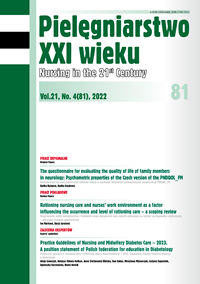Lifestyle of women and men with infertility
DOI:
https://doi.org/10.2478/pielxxiw-2022-0032Keywords:
infertility, lifestyle, reproductive healthAbstract
LIFESTYLE OF WOMEN AND MEN WITH INFERTILITY
Aim. To assess lifestyles of women and men having diffi culty conceiving a baby.
Material and methods. The study was carried out among 517 respondents (350 women and 167 men) suff ering from infertility. The online diagnostic survey method was applied. The authors’ own questionnaire was used along with the standardised FANTASTIC Life Questionnaire.
Results. More than a half of the women researched (60.3%) had appropriate BMI and every second man (49.1%) suff ered from obesity. Most of the respondents paid attention to the quality of food they had. Every third woman (30.3%) did exercise 3-4 times a week while most men (37.7%) once a week. The mean score of the FANTASTIC Life Questionnaire was 35.73 } 6.94 points chich means the group studied was characterised by a very good lifestyle.
Conclusions. The lifestyles of the resopndents was good or very good and only their physical activity, type of behaviour/personality traits or perception of themselves needed further improvement. Education of individuals who fail to conceive a baby is of great importance along with education of the entire society on the infl uence of lifestyle on reproductive health and the implementation of preventive measures to promote favourable health behaviours.
References
1. Gętek-Paszek M. Wpływ sposobu żywienia na płodność kobiet oraz mężczyzn – przegląd doniesień naukowych. [w:] Krzystyniaka KL, Klonowskiej J (red.): Nowe trendy w dietetyce. Warszawa: Wyd. Wyższej Szkoły Inżynierii i Zdrowia w Warszawie; 2019, s. 60-69.
2. Koperwas M, Głowacka M. Problem niepłodności wśród kobiet i mężczyzn – epidemiologia, czynniki ryzyka i świadomość społeczna. Aspekty Zdrowia i Choroby. 2017; 2 (3): 31-49.
3. Zatorska-Zoła M. Jakość i styl życia w perspektywie nauk społecznych i medycznych. Rzeszowskie Studia Socjologiczne. 2018; 9: 40-48.
4. Aydin T, Karadağ MA, Demir A, et al. Eff ect of Modifi cation of Lifestyle on Reproductive Potential. Kafkas. J. Med. Sci. 2014; 4(1): 27-35.
5. Hart RJ. Physiological aspects of female fertility: role of the environment, modern lifestyle, and genetics. Physiol. Rev. 2016; 96: 873-909.
6. Hayden RP, Flannigan R, Schlegel PN. The Role of Lifestyle in Male Infertility: Diet, Physical Activity and Body Habitus. Curr. Urol. Rep. 2018; 19(7): 56. doi: 10.1007/ s11934-018-0805-0.
7. Vitale SG, La Rosa WL, Petrosino B, et al.The Impact of Lifestyle, Diet, and Psychological Stress on Female Fertility. Oman. Med. J. 2017; 32(5): 443-444.
8. Deluga A, Kosicka B, Dobrowolska B, et al. Lifestyle of the elderly living in rural and urban areas measured by the FANTASTIC Life Inventory. Ann. Agric. Environ. Med. 2018; 25(3): 562-567.
9. Łukaszuk K, Kozioł K, Jakiel G, i wsp. Diagnostyka i leczenie niepłodności – rekomendacje Polskiego Towarzystwa Medycyny Rozrodu i Embriologii (PTMRiE) oraz Polskiego Towarzystwa Ginekologów i Położników (PTGP). Ginekol. Perinatol. Prakt. 2018; 3(3): 112-140.
10. Durairajanayagam D. Lifestyle causes of male infertility. Arab. J. Urol. 2018; 16: 10- 20.
11. Amjad S, Baig M, Zahid N, et al. Association between leptin, obesity, hormon al interplay and male infertility. Andrologia. 2019; 51(1): 13147. doi: 10.1111/and.13147.
12. Chavarro JE, Rich-Edwards JW, Rosner BA, et al. Diet and Lifestyle in the Prevention of Ovulatory Disorder Infertility. Obstet. Gynecol. 2007; 110 (5): 1050-1058.
13. Kim SY, Park ES, Kim HW. Eff ectiveness of Non-Pharmacological Interventions for Overweight or Obese Infertile Women: A Systematic Review and Meta-Analysis. Int. J. Environ. Res. Public. Health. 2020; 13; 17(20): 7438.
14. Komninos D, Ramos L, van der Heijden GW, et al. High fat diet-induced obesity prolongs critical stages of the spermatogenic cycle in a Ldlr-/-. Leiden mouse model. Sci Rep. 2022; 12(1): 430.
15. Jahangirifar M, Taebi M, Nasr-Esfahani MH, et al. Dietary Patterns and The Outcomes of Assisted Reproductive Techniques in Women with Primary Infertility: A Prospective Cohort Study. Int. J. Fertil. Steril. 2019; 12(4): 316-323.
16. Vaamonde D, Da Silva-Grigoletto ME, Garcia-Manso JM, et al. Response of semen parameters to three training modalities. Fertil. Steril. 2009; 92: 1941-1946.
17. Foucaut AM, Faure C, Julia C, et al. Sedentary behavior, physical inactivity and body composition in relation to idiopathic infertility among men and women. PLoS ONE. 2019; 14 (4): e0210770.
18. Witczak B, Klusek JE, Klusek J. Genetyczne aspekty niepłodności męskiej. Stud. Med. 2014; 30 (4): 276-279.
19. Bojanowska M, Kostecka M. Dieta i styl życia jako czynniki wpływające na płodność. KOSMOS Problemy Nauk Biologicznych. 2018; 2 (319): 425-439.
20. Sawaniewska B, Gajewska D, Lange E. Wpływ sposobu żywienia na płodność kobiet i mężczyzn. KOSMOS Problemy Nauk Biologicznych 2019; 2 (323): 227-237.
21. Ricci E, Al-Beitawi S, Cipriani S, et al. Dietary habits and semen parameters: A systematic narrative revive. Andrology. 2018; 6: 104-116.
22. Pasternak-Winiarska A. Wybrane czynniki środowiskowe a ryzyko niepłodności mężczyzn. KOSMOS Problemy Nauk Biologicznych. 2019; 2(323): 239-247.
23. Sitarz AM, Wojtowicz AK. The impact of tobacco smoke on women’s fertility. Environ. Med. 2015; 2(18): 11-16.
24. Kozakiewicz B, Dulęba M, Deptała A. Impact of lifestyle on fertility – a review of the literature. Hygeia Public Health. 2019; 54(3): 173-181.
Downloads
Published
Issue
Section
License
Copyright (c) 2022 Authors

This work is licensed under a Creative Commons Attribution 4.0 International License.




